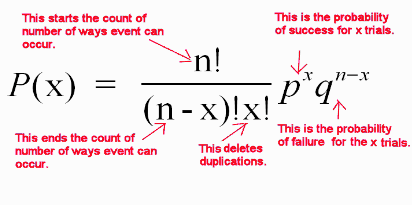-
A Binomial Distribution, Brief Summary

-
- Flip a coin 4 times (or flip 4 coins) and count the number of heads. The coin doesn't even need to be a fair coin
(in which a tail is as likely as a head). The experiment is described by a binomial distribution.
-
- An only two-possible-outcome experiment, repeated a certain number of independent times is called
binomial. The distribution or function has as a variable x, the number of successes. The other required parameters are n, the number of
independent trials, and p, the probability of success. The probability of failure on each trial is q, or 1 - p.
-

- The mean and standard deviation of a BINOMIAL DISTRIBUTION are stated below.

|



![[MC,i. Home]](http://www.mathnstuff.com/math/spoken/here/1gif/mcihome.gif)
![[Table]](http://www.mathnstuff.com/math/spoken/here/1gif/table.gif)
![[Words]](http://www.mathnstuff.com/math/spoken/here/1gif/words.gif)

![[this semester's schedule w/links]](http://www.mathnstuff.com/gif/semestr.gif)
![[Good Stuff -- free & valuable resources]](http://www.mathnstuff.com/gif/goods.gif)
![[last]](http://www.mathnstuff.com/math/spoken/here/1gif/last.gif)
![[next]](http://www.mathnstuff.com/math/spoken/here/1gif/next.gif)